
Top Tops: How to Write a Contractor or Construction Proposal
Do you need to write a contractor or construction proposal? This guide will help you create proposals that win projects and satisfy clients by outlining scope, costs, and timelines using construction proposal software, examples, and templates.
Key Takeaways
- A well-written construction proposal is essential for winning projects, establishing trust, and communicating project details to clients.
- A construction proposal's critical components include an executive summary, detailed scope of work, accurate cost estimates, and a comprehensive project timeline.
- Customizing proposals to meet client needs and incorporating engaging visuals can significantly enhance their appeal and differentiate them from competitors' offerings.
- Understanding the process of construction proposal writing and knowing how to write a construction proposal are critical skills for creating proposals that can win contracts and showcase your company's capabilities.
Understanding Construction Proposals
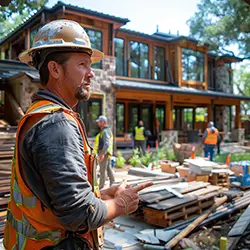
A construction proposal is the cornerstone of a successful construction bid. It is a detailed plan and a communication tool between contractors and clients. A construction proposal can include a construction project proposal, a response to a government construction RFP, or a funding proposal. For large and small construction companies, a well-prepared proposal can significantly influence the bidding process and contract negotiations in a competitive industry. A construction proposal template can streamline this process with a prepared, structured document. A proposal writing system, such as Proposal Kit that can create templates on the fly based on specific requirements, should be used instead of a static template.
These proposals showcase contractors' capabilities, helping them market their business and secure new projects. An effective proposal is a vital communication tool for a construction firm, outlining project details such as scope, cost, and timelines, which are essential for securing contracts and successfully executing construction projects.
The importance of a well-written construction proposal cannot be overstated. It builds client trust, ensures clarity on project expectations, and shows how you will comply with necessary permits and building codes. However, preparing these proposals can be challenging due to the dynamic nature of project scopes.
Definition of Construction Proposal
A construction proposal is a document designed to outline the details of a construction project and facilitate communication between the contractor and the client. Key components include the project scope, estimated costs, and timelines, ensuring that every topic is covered.
A construction contract is typically signed after the proposal is accepted. This legal binding ensures that both parties are committed to the agreed terms, providing a clear framework for project execution. Consult your attorney to ensure your contracting contracts are correctly written. Contracts from online sources are typically offered as self-help content for informational purposes and are not legal advice.
Importance of a Well-Written Proposal
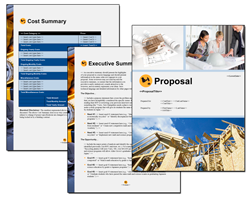
A well-written construction proposal is crucial for winning projects and differentiating a contractor from the competition. It showcases the contractor's competencies, establishes trust, and fosters a positive working relationship with the client. To succeed, writing a construction proposal that communicates these elements is essential.
Clear communication in a proposal helps ensure everyone understands the project objectives and execution plans, reducing the chances of misunderstandings. Proposals that are clear and professional not only set clear expectations but also reflect the company's image and strengths, significantly influencing the client's decision-making process.
Critical Elements of a Construction Proposal
A robust construction proposal includes:
- An executive summary
- Detailed scope of work
- Cost estimate and breakdown
- Payment schedule
- Project timeline
- Project bid
These components ensure that all aspects of the project are covered, providing a clear and comprehensive plan for both the contractor and the client.
Executive Summary
As the first section clients read, the executive summary is vital for engaging them from the start. This section concisely outlines the proposal's main points, covering the project's scope, timeline, and cost. A well-structured executive summary captures the client's interest and sets the stage for the entire proposal.
Detailed Scope of Work

A construction proposal's scope of work section describes all tasks and activities to be completed in detail. It includes specific deliverables, materials, labor, equipment requirements, and timelines.
A detailed scope of work clarifies responsibilities, preventing misunderstandings and ensuring smooth project execution.
Cost Estimate and Breakdown
Providing a detailed cost estimate fosters transparency and trust. It should include a budget breakdown of labor, materials, equipment, permits, and other expenses.
A line-item breakdown clarifies labor, materials, and permits, aiding in maintaining a good reputation and building client trust.
Payment Schedule
The payment schedule is integral to a construction proposal as it outlines the payment amounts, due dates, and overall payment plan. Detailing the frequency and quantities owing for payments and penalties for late payments helps manage client expectations and prevent future disputes.
Project Timeline
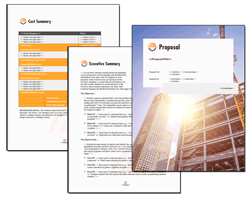
The project timeline includes a detailed schedule, expected start and completion dates, and critical milestones. It also provides for the duration of each phase and mentions workflow checkpoints to keep all parties aware of the scheduled completion dates and ensure alignment with the client's project objectives.
The Proposal Kit software's line-item database is also used to create schedules in addition to your financial chapters.
Creating Your Construction Proposal with Proposal Kit
Creating a complex construction proposal can seem daunting, but the Proposal Kit simplifies and streamlines the process. Using construction proposal template layouts from Proposal Kit ensures that all necessary information is included, and the software system is particularly well-suited for responding to Requests for Proposals (RFPs).
The Proposal Kit includes an extensive library of construction and contracting proposal samples and layouts for various construction projects.
Proposal Kit streamlines the creation process and enhances the quality and professionalism of your proposals. Using these templates lets you focus more on customizing content to meet specific client needs rather than worrying about structure and formatting. Construction proposal templates improve efficiency and accuracy and enhance your chances of securing bids, ultimately boosting your reputation and profitability.
Using Proposal Kit Templates

Proposal Kit templates ensure all necessary information is included, providing a comprehensive structure that covers every detail.
These templates also enable quick and easy bid preparation, saving time and effort. Customizable templates allow you to tailor your bids and proposals to meet specific project needs, ensuring all essential details are noticed.
You can import all these samples and layouts into a project using the Proposal Kit's Wizard software, which can then be customized and assembled into a proposal document.
Here are some related samples included in every downloadable Proposal Pack
The AI Writer generates a first draft of these templates - customized to your company, client, and project - in just minutes, giving you a head start on editing. Get any Proposal Pack or Proposal Kit Professional, and all of these samples, and the AI Writer are included.
- Contractor Home Remodel Services Proposal
- Commercial Contracting Office Remodel Proposal
- Custom Home Building Proposal
- DOH Federal Government Grant Proposal
- Environmental Program Sample Proposal
- Energy Efficiency Sample Proposal
- Network Cabling Sample Proposal
- Painting Contractor Sample Proposal
- Plumber Services Sample Proposal
- Heating and Air Conditioning Sample Proposal
- Roofing Contractor Sample Proposal
- Electrical Contractor Sample Proposal
- Architectural Design Sample Proposal
- Request for Proposal (RFP) Sample
- Welding and Fabrication Services Sample Proposal
- Masonry Contracting Services Sample Proposal
- Fire and Safety Request for Proposal (RFP) Sample
- Civil Engineering Construction Sample Proposal
- Equipment Maintenance and Repair Sample Proposal
- Smart Home Automation Project Sample Proposal
- Woodworking Contractor Services Sample Proposal
- Heavy Equipment Leasing Sample Proposal
- Interior Decorator Design Services Sample Proposal
Here are some related downloadable templates
The AI Writer generates a first draft of these templates - customized to your company, client, and project - in just minutes, giving you a head start on editing. Get any Proposal Pack or Proposal Kit Professional, and all of these templates and the AI Writer are included.
- 3D Printed Building Construction Proposal
- Bathroom Remodel Proposal Template
- Commercial Contracting Office Remodel Proposal
- Commercial HVAC Proposal Template
- Commercial Painting Project Proposal
- Concrete Cutting Services Proposal
- Construction Project Proposal (Short)
- Contractor Bath and Kitchen Remodel Services Proposal
- Contractor Home Remodel Services Proposal
- Contractor Services Proposal
- Custom Home Building Proposal
- Demolition Proposal Template
- Demolitions Construction Project Proposal
- Drilling Project Proposal
- Elevator and Escalator Sales and Service Proposal
- Flooring Contractor Proposal
- Glass and Glazing Contractor Proposal
- HVAC Proposal Template
- Heating and Air Conditioning Proposal
- Home Audio and Theater Installation Proposal
- Home Construction Proposal
- Lighting Design and Installation Services Proposal
- Masonry Contractor Proposal
- Concrete Proposal Template
- Builder Proposal Template
- Building Construction Proposal Template
- Building Proposal Template
- Construction Bid Proposal Template
- Construction Contract Proposal Template
- Construction Proposal Template
- Design Build Proposal Template
- Kitchen Design Proposal Template
- Contractor Proposal Template
Customizing Your Proposal
Customizing your construction proposal is essential to address specific client needs and goals. You can edit colors, images, typography, and text to brand the document and match the visual look of your company logo, website, and so on.
Personalizing your proposal with elements like a company logo, customized fonts, and a tailored cover letter enhances its visual appeal. It adds a personal touch, making it more engaging for potential clients.
Incorporating Visuals and Design Themes
An attractive visual presentation can significantly enhance your construction proposal's impact. Engaging visuals make your proposal stand out and capture client interest. Proposal Kit offers a variety of templates and design tools that make it easy to incorporate visuals, creating a proposal that showcases your professionalism.
Enhancing Your Proposal with Additional Information
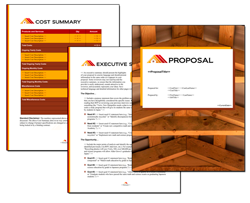
A construction proposal is more than just a document; it's a powerful tool for marketing your services and highlighting your capabilities. Enhancing your proposal with additional information that addresses specific client needs and showcases your expertise is essential to standing out. Using construction proposal examples can provide inspiration and guidance for creating winning proposals.
Tailoring your proposal helps differentiate it from others and ensures it resonates with the client's requirements. Detailed specifications of all parties involved and their names, addresses, and project details enhance the proposal's clarity and effectiveness.
Contractor Qualifications and Experience
Showcasing your company's qualifications and experience in the proposal is crucial for winning business and facilitating client decision-making. Showcasing your expertise, professionalism, and commitment to quality builds trust, which is essential for a successful project.
Client testimonials enhance credibility and reassure potential clients of your capabilities.
Legal Terms and Conditions
Clear legal terms and conditions ensure both parties understand their rights and obligations, helping to avoid disputes. Once accepted and signed, the agreement becomes a legally binding contract. As mentioned, consult your attorney to ensure your legal agreements are correctly written.
The contract should include liability waivers, dispute resolution procedures, and project delay clauses.
Social Proof and Case Studies

Social proof, such as testimonials and case studies, is critical in establishing trust with potential clients. Detailed testimonials can significantly boost your proposal's credibility.
Case studies should focus on challenges faced and their resolutions, showcasing your ability to deliver effective solutions.
Mistakes to Avoid
Even the most experienced contractors can make mistakes when preparing construction proposals. These mistakes can harm client confidence and reflect poorly on your professionalism. Inaccurate cost estimates, vague language, and failing to address specific client needs are among the most common pitfalls.
Understanding their impact is critical to avoiding these mistakes. Inaccurate cost estimates can lead to financial disputes and project delays, while vague language can make determining the project's scope and responsibilities difficult and lead to misinterpretation. Addressing client needs explicitly in the proposal ensures alignment and fosters trust.
Vague Language
Using ambiguous terms in your construction proposal can confuse parties about project expectations and responsibilities. Issues can arise from unclear wording, leading to confusion and potential disputes.
Ensuring specificity and clear definitions, especially when using technical jargon, adds credibility and demonstrates a well-thought-out plan.
Inaccurate Cost Estimates
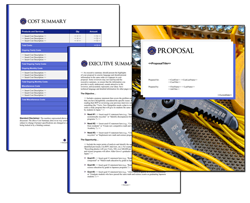
Inaccurate cost estimates undermine trust, leading to financial disputes and project delays. Thorough and precise budgeting is critical to avoid these pitfalls and ensure project success.
Precise definitions of terms in cost estimates mitigate the risk of stakeholder misinterpretations.
Ignoring Client Needs
Addressing clients' needs is crucial for developing a construction proposal that meets their expectations and concerns. Customizing your proposal to align with the client's vision and objectives demonstrates commitment to their project and enhances credibility.
Including qualifications, experience, and client testimonials fosters trust and assures clients of your capabilities.
Proposal Kit Success Stories
Proposal Kit has numerous success stories demonstrating how effective construction proposals can secure projects. Using Proposal Kit increases the likelihood of project approval, ensuring a higher success rate for contractors.
Summary
 Proposal Kit Professional provides the most content, including legal contracts and a free design theme pack. Plus, advanced software features include custom branding and customizable quoting databases.
Proposal Kit Professional provides the most content, including legal contracts and a free design theme pack. Plus, advanced software features include custom branding and customizable quoting databases. Proposal Pack for Any Business covers this type of proposal and includes samples. There are also some commonly used specialty design themes available:
Proposal Pack for Any Business covers this type of proposal and includes samples. There are also some commonly used specialty design themes available:Photo Design Proposal Packs
 Proposal Pack Architecture #3
Proposal Pack Architecture #3 Proposal Pack Architecture #4
Proposal Pack Architecture #4 Proposal Pack Classic #19
Proposal Pack Classic #19 Proposal Pack Construction #5
Proposal Pack Construction #5 Proposal Pack Construction #6
Proposal Pack Construction #6 Proposal Pack Construction #7
Proposal Pack Construction #7 Proposal Pack Construction #8
Proposal Pack Construction #8 Proposal Pack Contemporary #20
Proposal Pack Contemporary #20 Proposal Pack Decorator #3
Proposal Pack Decorator #3 Proposal Pack Decorator #4
Proposal Pack Decorator #4 Proposal Pack Electrical #4
Proposal Pack Electrical #4 Proposal Pack Electrical #5
Proposal Pack Electrical #5 Proposal Pack HVAC #2
Proposal Pack HVAC #2 Proposal Pack Industrial #3
Proposal Pack Industrial #3 Proposal Pack Janitorial #3
Proposal Pack Janitorial #3 Proposal Pack Painter #3
Proposal Pack Painter #3 Proposal Pack Painter #4
Proposal Pack Painter #4 Proposal Pack Plumbing #2
Proposal Pack Plumbing #2 Proposal Pack Real Estate #5
Proposal Pack Real Estate #5 Proposal Pack Real Estate #6
Proposal Pack Real Estate #6 Proposal Pack Real Estate #7
Proposal Pack Real Estate #7 Proposal Pack Real Estate #8
Proposal Pack Real Estate #8 Proposal Pack Roofing #2
Proposal Pack Roofing #2 Proposal Pack Safety #5
Proposal Pack Safety #5 Proposal Pack Skyline #4
Proposal Pack Skyline #4
Line Art Design Proposal Packs
A well-written construction proposal is the key to winning new projects and establishing a solid client relationship.
Understanding the key elements of a proposal, using a tool like Proposal Kit, and enhancing your proposals with additional information can help you create winning construction proposals.
Avoid common mistakes, such as vague language and inaccurate cost estimates, and always address your client's needs.
With the right approach and tools, your construction proposals can stand out, showcasing your professionalism and commitment to quality. Start creating your proposals today and see the difference a well-written construction proposal can make in securing successful projects and building lasting client relationships.
Frequently Asked Questions
What are the critical components of a construction proposal?
To create a construction proposal, include an executive summary, a detailed scope of work, a precise cost estimate and breakdown, a payment schedule, and a well-defined project timeline. This structured approach will set you apart and help you win more projects!
How can Proposal Kit help in creating construction proposals?
Proposal Kit makes creating construction proposals easy and efficient by providing templates that ensure you include all necessary information. This saves you time and helps you present a professional and comprehensive proposal.
Why is it essential to customize a construction proposal?
Customizing a construction proposal is crucial because it directly addresses your client's unique needs, making it more engaging and appealing. Adding a personal touch significantly increases your chances of winning the project!
What are common mistakes to avoid in construction proposals?
To succeed in construction proposals, avoid vague language, inaccurate cost estimates, and neglecting client-specific needs. Clear communication and detailed planning will set you apart!
How can social proof enhance a construction proposal?
Social proof significantly enhances a construction proposal by showcasing testimonials and case studies that build credibility and establish trust with potential clients. This demonstrates your proven ability to deliver effective solutions, making your proposal more compelling.



 Cart
Cart
 Are you just looking for a template, sample, or software for your contracting and construction proposals? Click these links to skip down the page and get right to it.
Are you just looking for a template, sample, or software for your contracting and construction proposals? Click these links to skip down the page and get right to it.





 Facebook
Facebook YouTube
YouTube Bluesky
Bluesky Search Site
Search Site